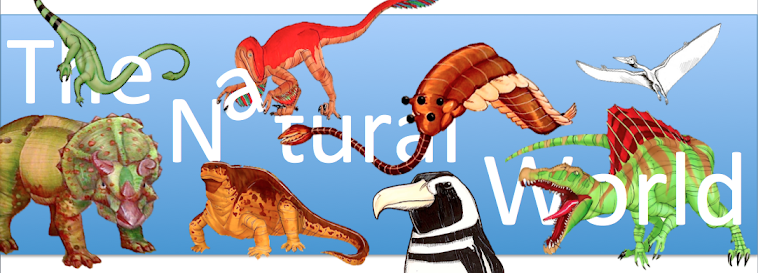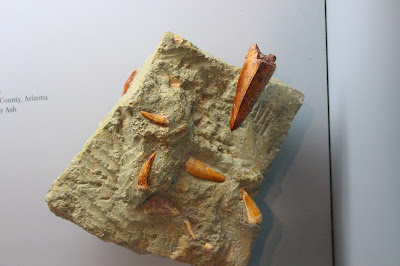In the new
Jurassic World movie, the main movie monster is a critter that the movie characters called
Indominus rex. The
dinosaur is a big guy, and its forearms are especially large, especially when compared to the tiny arms of
Tyrannosaurus rex. There were a few funky things going on with the Jurassic World dinosaur hands, but we can talk about that in a later post. Today, we are going to talk about an interesting type of behavior exhibited by
Indominus: facultative bipedalism.
 |
| Two baby Stegosaurus models on display at the Morrison Natural History Museum. Stegosaurus individuals of all sizes would have been able to switch between walking on two and four legs, facultative bipedalism, which is the topic of this post. |
Facultative bipedalism is an animal that can walk on both two or four legs, at least for a little bit. For example, the
gerenuk (
Litocranius walleri), a type of
African antelope, can rear up on their hind legs to nab plants off of some higher branches. But they can't really walk on their hind legs, so they wouldn't really be considered facultative bipeds. My little Djungarian hamster (
Phodopus sungorus) will lean back on his hind limbs to manipulate food with his forepaws, as do many other types of rodents. Meerkats (
Suricata suricatta) often sit on their hind legs to observe their surroundings. The extinct
giant ground sloths would have reclined on their haunches to browse from the higher branches of
trees. But none of them would have moved around on their hind limbs, and therefore would not be classified as bipeds, facultative or otherwise.
 |
| Several gerenuk at Walt Disney World in Florida using their hind legs to eat some food off of the higher branches. Photo Credit: Julie Neher |
 |
| Another rodent manipulating an object with its forepaws. This North American porcupine (Erethizon dorsatum), also at the Cheyenne Mountain Zoo, is holding a primitive slingshot weapon. Zookeepers have had a very difficult time controlling these animals. |
 |
| A meerkat at the Cheyenne Mountain Zoo, using part of its termite mound as a lookout area. It'll stand on its hind legs, but runs around on all fours. |
 |
| A Jefferson's ground sloth (Megalonyx jeffersoni) exaggerates the size of the fish it caught last summer at the Rocky Mountain Dinosaur Resource Center (RMDRC) in Woodland Park, Colorado. Just like the gerenuk, the ground sloths would have reared up on their hind legs to consume vegetation off of a higher level. |
The
duck-billed
hadrosaur dinosaurs and the iguanodonts are good examples of facultative bipeds. They would have been capable of moving around on both two or four legs, depending on whether they were grazing lazily (quadrupedal) or moving more quickly (bipedal).
 |
| An Anatotitan skeleton on display at the American Museum of Natural History in New York. You can see this skeleton is moving around on all fours.... |
 |
| ....but the animal could also walk bipedally. |
Stegosaurus was initially thought to be bipedal, and although most modern reconstructions show the armored dinosaur as a quadruped,
fossil trackways at the
Morrison Natural History Museum (MNHM) in
Colorado demonstrate quite clearly that the baby
Stegosaurus, tiny little six pound hatchlings, were entirely capable of moving around on their back legs!
For
stegosaur and hadrosaur dinosaurs, most of their weight was centered over their hips, and the same is true of some of the long-necked dinosaurs, such as
Apatosaurus and
Brontosaurus. Fossil trackways of baby
Apatosaurus at the MNHM show that the babies could run around on their hind legs, to keep up with their parents, and probably keep out of their way as well! The little baby
Apatosaurus tracks at the MNHM show the animal scooting along on its back legs, sort of like the modern basilisk lizard from
South America.
 |
| Two trackways made by infant apatosaur dinosaurs, on display at the Morrison Natural History Museum. The lower trackway has tracks from both the front and back feet, while the upper trackway has only hind foot tracks, and are spaced two to three times further apart than the ones in the lower trackway. This shows that these baby dinosaurs would have been capable of running around on their hind legs! |
Very few mammals are facultative bipeds, or even bipeds at all, with exceptions such as
pangolins, jerboas, and kangaroo rats, as well as the regular old
kangaroos. Apparently, even cockroaches in the genus
Periplaneta can run on their hind legs as well, if they get going fast enough!
 |
| A Parma wallaby at the Cheyenne Mountain Zoo, moving around on its hind limbs. |
 |
| Here, you can see the same Parma wallaby, moving on all four legs. |
 |
| A mounted skeleton of the Pleistocene kangaroo Simosthenurus at the American Museum of Natural History in New York. As you can see, even though it looks like its twerking, it is on its hind legs, grabbing some vegetation. |
Although
Indominus was never shown really running on all four legs, and most of the time seemed like a biped, there were a few times where the beast would drop down to all four legs. At those times,
Indominus looked a bit like some of the earliest dinosaurs might have, as well as their close cousins.
Poposaurus and
Postosuchus are both dinosaur cousins for whom the possibility of facultative bipedalism, or just regular bipedalism, has been suggested in the past. Even if those specific critters weren't facultative bipeds, there were definitely cousins of theirs that were.
Works Cited:
Alexander, R. (n.d.). Bipedal animals, and their differences from humans. J Anatomy Journal of Anatomy, 321-330.
Weinbaum, J. (2013). Postcranial skeleton of Postosuchus kirkpatricki (Archosauria: Paracrocodylomorpha), from the Upper Triassic of the United States. Geological Society, London, Special Publications, 525-553.


























































